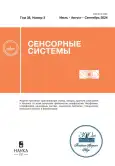卷 38, 编号 3 (2024)
ОБЗОРЫ
Auditory System of Blood-Sucking Mosquitoes (Diptera, Culicidae)
摘要
This review comprehensively explores the morphology of the mosquito auditory organs – antennae and Johnston’s organs. Spatial and frequency characteristics of auditory sensory neurons within Johnston’s organs are discussed, as well as the mechanisms of mechanotransduction in these neurons. The review presents findings from studies investigating the aspects of mosquito perception of acoustic signals when their auditory system is subjected to vibrations generated by flapping wings. Additionally, the review discusses the significance of acoustic communication in the reproductive behavior of mosquitoes.
 3-30
3-30


Development of Image Pre-Processing Methods for Software Compensation of Anomal Refraction of the Observer’s Eyes
摘要
In recent decades, the practice of demonstrating various static and video images to users using digital, processor-controlled, most often self-luminous devices (computer monitors, smartphone and tablet screens, etc.) has spurred the development of various methods to improve the perception of such images by means of computerized image preprocessing. This also applies to methods of preprocessing images shown to users with various refractive anomalies of the eye(s) (e.g., myopia or astigmatism) in situations where they are not armed with glasses or other corrective devices. Over the past 20+ years, researchers have published dozens of papers on this task, referred to as the precompensation task. In our opinion, the time has come to reflect on the development of scientific thought in this direction and to highlight the most important milestones in realizing the problems on the way to achieving “ideal” precompensation and in approaches to their successful solution. This is the focus of the first part of this review. In the second part, we focus on the current state of research in the stated area, highlight the problems not solved so far, and try to catch the trends of further development of image precompensation methods, paying maximum attention to neural network approaches.
 31-50
31-50


СЛУХОВАЯ СИСТЕМА
Perceived Trajectories of Cyclic Sound Movement
摘要
Binaural beats are a phenomenon that occurs during dichotic stimulation due to binaural integration. It takes the form of cyclic movement of the sound image in the listener’s acoustic space when the beat frequency range is below 3 Hz. Our subjects used the inserted earphones to listen to the stimuli that created a sense of sound movement due to changes in the interaural time difference (ITD). We used three types of dichotic stimuli which simulated smooth azimuthal cyclic movement and cyclic abrupt shifts. The ITD changes determined central or lateral positions of movement trajectories. The results confirm that both types of movement created the effect of binaural beats. The range of beats depended on the spatial position of the trajectory: in the frontal sector of acoustic space, the range of beats was greater than on the left or right. The perceived trajectories of smooth motion were shorter than the trajectories of abrupt shift. The influence of spatial position on the perceived trajectory length is interpreted from the standpoint of nonlinear features of lateralization. It is suggested that the effect of ITD pattern on the perceived trajectory length is mediated by temporal integration mechanisms of binaural hearing.
 51-62
51-62


MODELING OF SENSORY PROCESSES
About the Possibility of Using Fixation Microsaccades to Improve the Quality of Visible Images in the Foveal Zone
摘要
The article is devoted to the description and analysis of a computer model that was created by D. S. Lebedev to demonstrate the possibility of a positive effect of fixation microsaccadic eye movements on the perception of small stimuli. The model is based on the assumption that in the process of fixing the gaze on the test stimulus, several “neural images” of this stimulus, resulting from microsaccades, are summed up in the brain. The series of summed neural images correspond to a sequence of shifted positions of the optical image of a stimulus on the retina. To accurately superimpose neural images on each other, a mechanism for compensating fixation saccadic microshifts is introduced into the model, identical to the mechanism that ensures the constancy of spatial perception in the case of macrosaccades, i.e. when turning the eyes to view large objects or scenes. The author of the model assessed the possibility of improving the quality of visible images by increasing the signal-to-noise ratio, which can be achieved using realistic spatiotemporal parameters of test images, neural noise and eye micromovements, selected bу means of literature analysis. Results of model calculation obtained for the specific parameters of the retina and eye movements showed that the considered summation mechanism with compensation for saccadic shifts can progressively improve the quality of visible test stimuli when the number of summed neural images increases to approximately seven or eight, after which the positive effect practically does not increase. In this article, based on the material of recordings of eye movements in relevant experiments, the degree of realism of this model is discussed.
 63-81
63-81


Methodological Recommendations for the Creation of Sensor Measurement Systems for Respiratory Rate Monitoring Based on Photoplethysmographic Signal Processing
摘要
A methodical apparatus for creating sensor measurement systems for monitoring human respiration rate is proposed. It includes a method for estimating respiratory rate based on statistical analysis of photoplethysmographic signals (human pulse wave), a method for selecting priority regions for estimating respiratory rate, and a criterion for determining the required bracelet tension during measurements. The application of the respiratory rate estimation method involves calculating the Correntropy spectral density of the pulse wave signal. A distinctive feature of the method is the use of an algorithm for selecting the priority empirical mode of the Hilbert-Huang decomposition, which is most closely related to the respiratory rate. Experimental verification of the method showed that the mean value of the absolute error for 58.8% of the sample of calculated respiratory rate values did not exceed 1 breath/min, and the 95% confidence interval for the mean absolute error of the entire sample was [0.72–2.2] breaths/min.
 82-94
82-94











